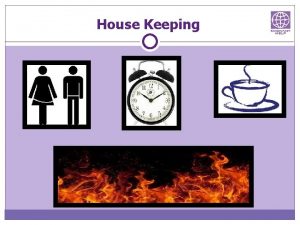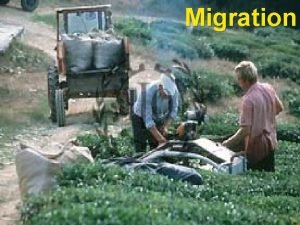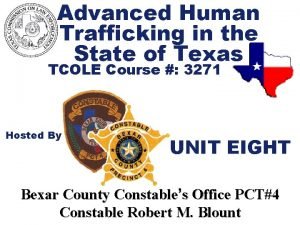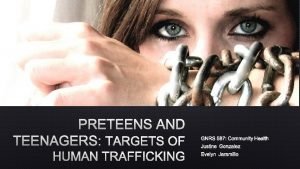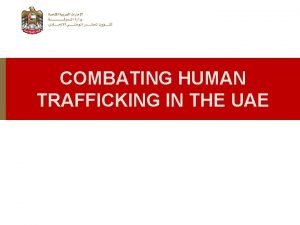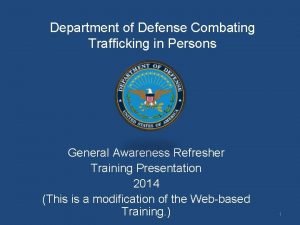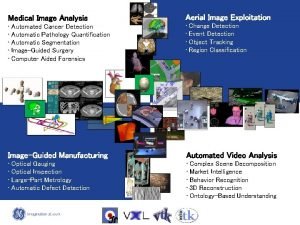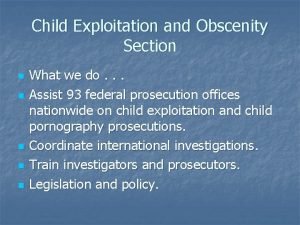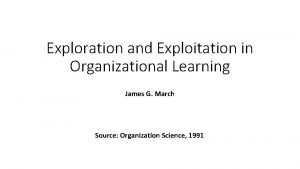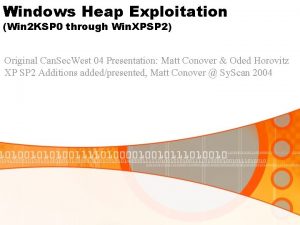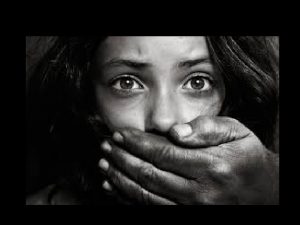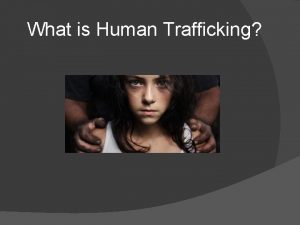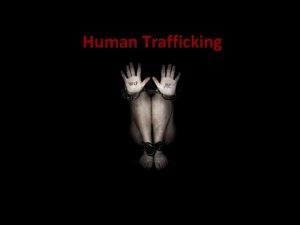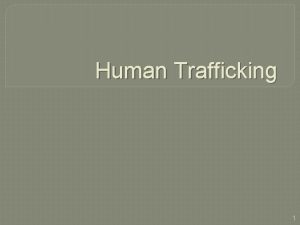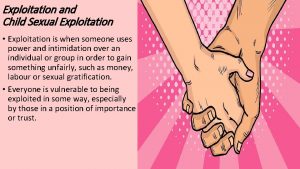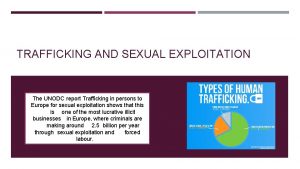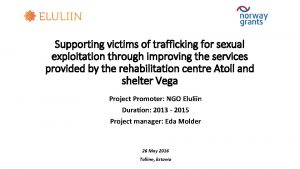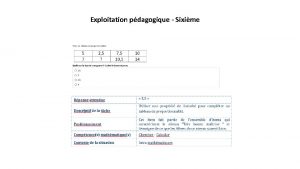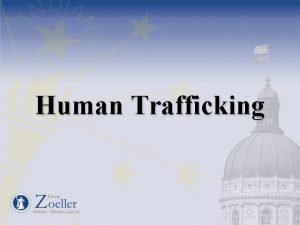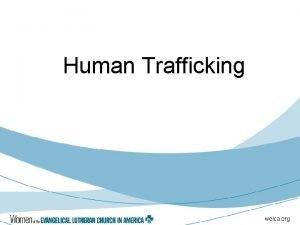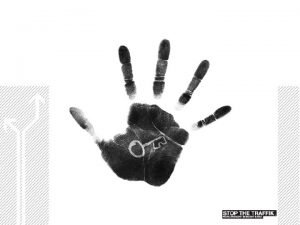Human Trafficking Secondary Exploitation and Mythologies of Victims
















- Slides: 16

Human Trafficking, Secondary Exploitation, and Mythologies of Victims, Pimps and Other Third Parties Dr. Anthony Marcus, Ph. D, amarcus@jjay. cuny. edu Chairman of the Anthropology Department, John Jay College of Criminal Justice

Sex Trafficking: Frames vs Facts • A cursory search on the internet for terms yields: 1. “Sex Trafficking” 7, 640, 000 results 2. “Pimps” 9, 280, 000 results 3. “Sex Traffickers” 921, 000 results 4. “Sex Trafficking Victims” 1, 470, 000 results 5. “Prostitutes” 34, 300, 000 results

Sex Trafficking: Frames vs Facts Claims: Profits 1. Fastest Growing Criminal Industry 2. 30 to 150 Billion Dollars Profit 3. The Scourge of Our Times? Facts: We simply do not have evidence 1. There is no evidence to support the idea trafficking is expanding. 2. These figures are estimates; the UNODC reports that it cannot make reliable estimates on sex trafficking. 3. The scourge of our times… Perhaps for other reasons.

Why is it hard to find traffickers and victims? • Trafficking Definitions are constantly changing • Good Empirical Research is rare • Trafficking in the Sex Industry is conflated with Prostitution • Pimping and Trafficking are collapsed • The Standards of Force Fraud and Coercion are vague • Police are not properly trained to find victims of trafficking • Service Providers’ representations of trafficked people are equally confusing

Sound Empirical Research • The Atlantic City Study in NJ • The CSEC Study in NYC • The Study on Pimps in Harlem • The Study on NY Human Trafficking Intervention Courts • * these empirical studies reveal different typologies of victims, pimps, traffickers and third parties

Pimp Typologies Resource Sharing Model • Resource Sharing Model is an Pimps • Most pimps are part of an exchange process in underground interdependent underground economy: economies where participants combine drugs, sex services, and anything one resources and skills to achieve/maintain could hustle. a shared goal (Morselli, 2014) • The Domestic Pimp (baby sits, cleans, cooks) • The Partner Pimp (both members of dyad work to support themselves).

Pimp vs Trafficker • Traffickers are not pimps. Although sometimes these categories overlap, most pimps are unwilling to engage in trafficking. • Traffickers are hard to detect, mostly because human smugglers, pimps and other third parties involved in migration assistance are not traffickers, meaning that the conditions for trafficking (force, fraud, coercion) do not objectively meet. • Prosecutors force these conflations because trafficking convictions provide social and cultural capital, in addition to political and professional influence. • Prosecutors are now bringing Expert Witnesses on trafficking cases, to spin convincing tales to help conviction. • The formula is effective because of Daubert standards

Daubert Standards in Sex Trafficking Trials • Qualification Standards abysmally low • Government’s Expert Witnesses 1. Absolutely no understanding of research methods 2. Practitioners (therapists, MD, law enforcement, other service providers), who are not researchers or social scientists. 3. Practitioners are applying concepts learned in professional training 4. Except for DNA, most of the forensic evidence used in the CJ system is subjective (non-scientific).

Victim Typologies; Human Trafficking Intervention Courts; Secondary Exploitation Claudia Cojocaru, MA, Lecturer, Anthropology Department, John Jay College of Criminal Justice ccojocaru@jjay. cuny. edu

Virtuous vs Depraved Victimhood • The way “Sex Trafficking Victims” are socially constructed is to primarily justify lobbying, policy change, and provide law enforcement with bodies to prosecute. • Kai Erikson calls this process “deployment patterns” where deviant humans are useful to a society for set the standards against which norms are validated. • Sex Trafficking Victims are an evolving concept, controlled by ideology and framed to elicit emotional responses from the public and policy makers. • As formerly trafficked myself, I find the shape shifting nature of US based sex trafficking victimhood discourse degrading and disconnected from reality.

Labeling Women Deviant Trafficked Sex Workers Voluntary Sex Workers • Most women were trafficked in the sex industry in the 1990 s up to 2005 • Sex workers are choosing to work in the sex industry • Most trafficking happened in the process of migration • • Women who were trafficked were aware they may have to engage in sex work when they left their homes Many sex workers operate alone, placing ads on the internet, or contracting a third party (pimp; madam; driver, etc. ). • Trafficked women who were repatriated decided to go back abroad to look for work This is not only in the US, but also in Japan (Mama-san, tencho); China (chicken-heads, mommies). • Most sex workers say they enter prostitution to make a living, not because they are traumatized. •

Trauma Bonding/ Stockholm Syndrome Myth 1. Trauma Bonding is an attempt to rebrand Stockholm syndrome, a pseudoscientific diagnosis attempting to explain behavior considered irrational in the context of captor-captive relationship. 2. Neither of these concepts is a valid medical or psychiatric diagnostic, or present in the DSM. There is no empirical evidence to support this. 3. However, the anti-trafficking movement pushes the concept, because it silences dissenters, and allows for legal acrobatics targeting sex workers’ due process rights, and catchy policy titles “like trauma informed care” 4. Research shows that traumatic experiences are more likely to be remembered by sufferers, given the evolutionary and survival value of it.

Human Trafficking Intervention Courts • • • Women arrested for prostitution are declared victims of trafficking and compelled to plead guilty fin exchange for social services. They are given a plea deal: attend 5 sessions with a service provider and get Adjournment in Contemplation of Dismissal (ACD) After 6 month of no contact with the CJ system, the case is dropped. • Most women take the deal, but fail to attend the sessions, which warrants additional intervention. • Prosecutors are unprepared, sloppy and cruel; they degrade the defendants, sabotage the cases, punish the ones who appear most defiant. • The HTIC are another revolving door/ triage for the carceral system.

Secondary Victimization Secondary victimization is a prolonged and compounded consequence of certain crimes, their framing and representation in the media; it results from multifaceted negative, judgmental attitudes and behaviors directed toward the victim, [which results] in a lack of support, condemnation, alienation and stigmatization of the victim. • (Campbell& Raja, 1999; p. 262)

Secondary Exploitation • Secondary exploitation refers to the production and commodification of symbolic goods by a dominant group, in the form of narratives, documentaries, films, images and legal conceptualizations of members of marginalized groups, simultaneously leading to and depending on, the censorship, silencing and punishment of dominated groups on the ground.

References • Horning, A. , & Marcus, A. (Eds. ). (2017). Third Party Sex Work and Pimps in the Age of Anti-trafficking. Springer. • Marcus, A. et al. (2014). Conflict and agency among sex workers and pimps: A closer look at domestic minor sex trafficking. The ANNALS of the American Academy of Political and Social Science, 653(1), 225 -246. • Marcus, A. et al. (2016). Pimping and profitability: Testing the economics of trafficking in street sex markets in Atlantic City, New Jersey. Sociological Perspectives, 59(1), 46 -65. • Cojocaru, C. (2016). My Experience is Mine to Tell: Challenging the abolitionist victimhood framework. Anti-Trafficking Review, (7). • Cojocaru, C. (2015). Sex trafficking, captivity, and narrative: Constructing victimhood with the goal of salvation. Dialectical Anthropology, 39(2), 183. • Morselli, C. , & Savoie-Gargiso, I. (2014). Coercion, control, and cooperation in a prostitution ring. The ANNALS of the American Academy of Political and Social Science, 653(1), 247 -265.
 Aims and objectives of human trafficking
Aims and objectives of human trafficking Advanced human trafficking #3271 test answers
Advanced human trafficking #3271 test answers Human trafficking grooming
Human trafficking grooming Human trafficking map
Human trafficking map Advanced human trafficking 3271
Advanced human trafficking 3271 Human trafficking
Human trafficking Human trafficking definition
Human trafficking definition What is human trafficking
What is human trafficking Combating human trafficking in the uae
Combating human trafficking in the uae 3271 advanced human trafficking
3271 advanced human trafficking Ctip for acquisition and contracting professionals
Ctip for acquisition and contracting professionals What is trafficking in persons
What is trafficking in persons Image analysis and exploitation
Image analysis and exploitation Entry strategy for new entry exploitation
Entry strategy for new entry exploitation Child exploitation and obscenity section
Child exploitation and obscenity section Exploration and exploitation in organizational learning
Exploration and exploitation in organizational learning Windows heap exploitation
Windows heap exploitation
